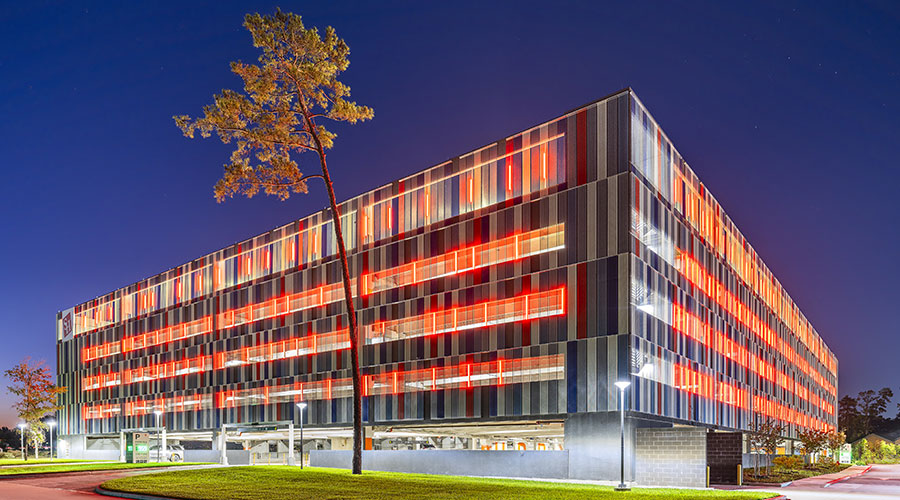New Energy Efficient Lighting Technologies
The lighting industry is continuously improving and developing new products geared toward reducing energy use while meeting the illumination requirements for a given space.
"Halogen lamps can be used to replace incandescent general service and parabolic aluminum reflector (PAR) lamps to provide energy savings, and in many cases, longer lamp life," says Anderson. "Compact fluorescent lighting (CFL) also can replace incandescent to deliver similar benefits. New, lower-wattage, pulse-start metal halide systems with electronic ballasts are another option that delivers energy savings and longer lamp life. Solid-state (LED) lighting also is a viable option for replacing incandescent, HID, halogen and CFLs in a variety of indoor and outdoor applications."
To understand the kind of savings new technologies yield, consider that a 65-watt incandescent bulb produces roughly the same amount of light as a 15-watt CFL or an 11-watt LED, assuming that each is using the same fixture, says Jeff Spencer, director of project management — commercial at Juno Lighting Group. He also says that newer technologies do more than slash energy consumption and utility budgets. Modern lighting systems also can reduce maintenance costs by delivering longer lamp life and easier replacement methods.
There are other benefits. "With all the dust, dirt and light depreciation in older buildings, new energy efficient lighting also can improve the appearance," says Spencer. "It makes a space look the way it is supposed to look. You get clean new lamps with an upgrade, and all of a sudden it looks new again."
Improvements in the energy performance of lighting technology has led the federal government to take action to drive the market to more efficient products. In 2000, DOE issued regulations requiring the phase out of magnetic T12 fluorescent ballasts for 4-foot linear lamps and 2-foot U-lamps with medium bi-pin bases, 8-foot linear lamps with single-pin bases, and 8-foot linear lamps with RDC bases. The Energy Policy Act of 2005 — widely known as EPAct — went further, requiring the phase out of ballasts for T12 energy saving lamps. As of last month, regulations bar the manufacture of T12 magnetic ballasts for use in both new fixtures and replacement applications.
What's more, by July 2012, new federal energy standards will eliminate the manufacture or import of many popular T12 lamps as well as a few T8 lamps.
Taken together, these regulations are pushing facility managers to abandon T12 systems in favor of more efficient T8 or T5 technology — options that have long made economic sense.
Replacing magnetic ballasts with electronic ballasts brings significant energy savings and environmental benefits, says Jeanette Strainic, manager of strategic initiatives and events at GE Lighting. "With new high-efficiency electronic ballasts, total system wattage can be reduced more than 40 percent relative to the use of older T12 fluorescent systems."
But replacing existing ballasts with electronic ones is only one option. Facility managers with facilities using T12 lamps and magnetic ballasts have other energy-efficient upgrade choices. For example, fixtures can be retrofitted to T8 lamps and electronic ballasts. Another route is to completely replace existing fixtures with either efficient T8 or T5 units with electronic ballasts or an entirely different technology.
As Casanova says, "Many facility managers look at lighting upgrades as just changing lamps or upgrading the ballast from magnetic to electronic." But there are other considerations. When selecting from the wide array of new technologies, factors to consider across a number of products include:
- Efficiency improvements (lumens per watt)
- Efficiency standards
- Environmentally conscious products
- Long-life products
For example, if a facility manager is considering an LED product based on the fact that it delivers high efficiency and long life, it is also important to consider the kind of fixture it requires for successful operation. LED fixtures may need to be replaced entirely when it's time to change the lamps. Ones with replaceable light engines extend the life of the fixture.
"It's bad for the environment if you have to throw away all of the fixtures in a building every five years," Spencer says. "It's only a matter of time before the replaceable light engine feature of some LED fixtures becomes a requirement rather than a nice option."
Related Topics:














